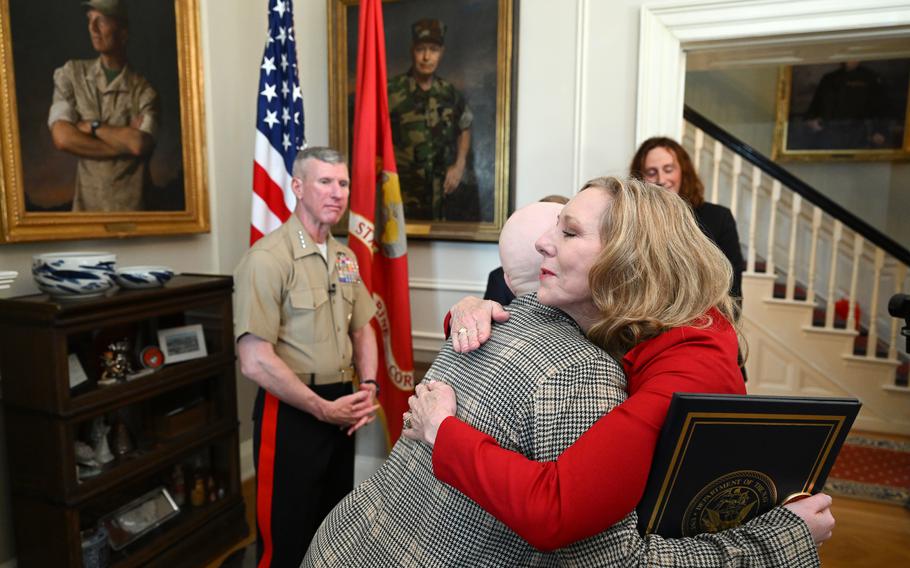
Joyce LaLonde embraces Patrisha Smith, in red, the wife of Gen. Eric M. Smith, left, as Gen. Smith recognizes Joyce and others during the ceremony Thursday. (Matt McClain/The Washington Post)
Gen. Eric M. Smith stepped out on a warm, late-afternoon run last fall, pounding the pavement of Southeast Washington on a routine three-mile loop. As the top U.S. Marine, he had spent the morning cheering on participants in the annual Marine Corps Marathon, and wanted to squeeze in his own workout before taking his wife out to dinner.
It was Oct. 29. A few blocks away, Timothy and Joyce LaLonde concluded a celebratory post-race lunch and began the walk back to Joyce’s nearby home. The siblings, accompanied by several family members, were shaken by what they encountered: A man facedown on the sidewalk - alone, unresponsive and bleeding from his mouth.
“Tim, come!” Joyce LaLonde recalled yelling to her brother. “Hurry!”
The ensuing scramble saved the life of the Marine Corps commandant, a father of two who had stepped into his new role on the Joint Chiefs of Staff just three months earlier. Smith, who turns 59 in June, suffered cardiac arrest at the tail end of his run, just a block from his home at Marine Barracks Washington - a crisis in which the speed and quality of medical intervention proved vital.
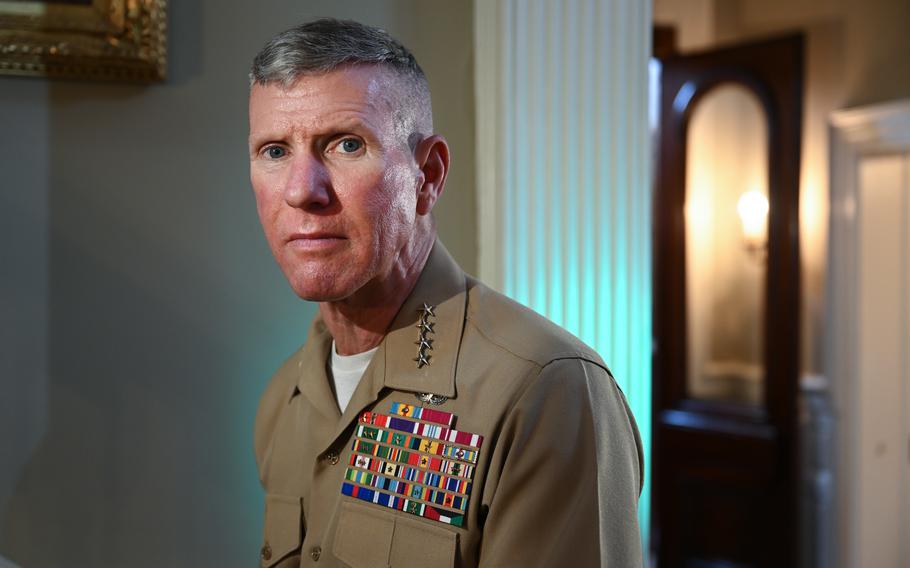
Marine Corps Gen. Eric M. Smith poses for a portrait at his residence at Marine Barracks Washington on Thursday, after a ceremony in which he recognized the three people who came to his rescue. (Matt McClain/The Washington Post)
For the first time, those directly connected to Smith’s rescue have publicly detailed how he survived, a fortuitous succession of events resulting in an improbable return to the Pentagon after barely four months of recovery. This account is based on hours of interviews with the general and eight others, including Smith’s surgeon and the paramedics who administered several electrical shocks to stabilize his heart.
What began with Joyce LaLonde spotting the general sprawled on the concrete and her brother, a certified CPR instructor, rendering aid ended, all agreed, with the best possible outcome.
“If you were to have this scenario play out 1,000 times, maybe five people … would survive it like he did,” said Smith’s cardiac surgeon, Thomas MacGillivray. “It’s an unusual thing that somebody gets CPR for that long and not just survives it, but is back to normal life within a couple of few months.” Impossible, he added, without everyone having provided the care they did.
On Thursday, Smith thanked Joyce and Timothy LaLonde and Joyce’s husband, Nathaniel Birnbaum, in a small ceremony at the commandant’s home. Each received the Navy Distinguished Public Service Award for their heroism, and will be recognized again Friday along with first responders during an “Evening Parade” event at the barracks featuring marching and music.
“You have really given me a second chance,” Smith said, pinning the medal, with its blue and yellow ribbon, to their chests. “I’m grateful to you.”
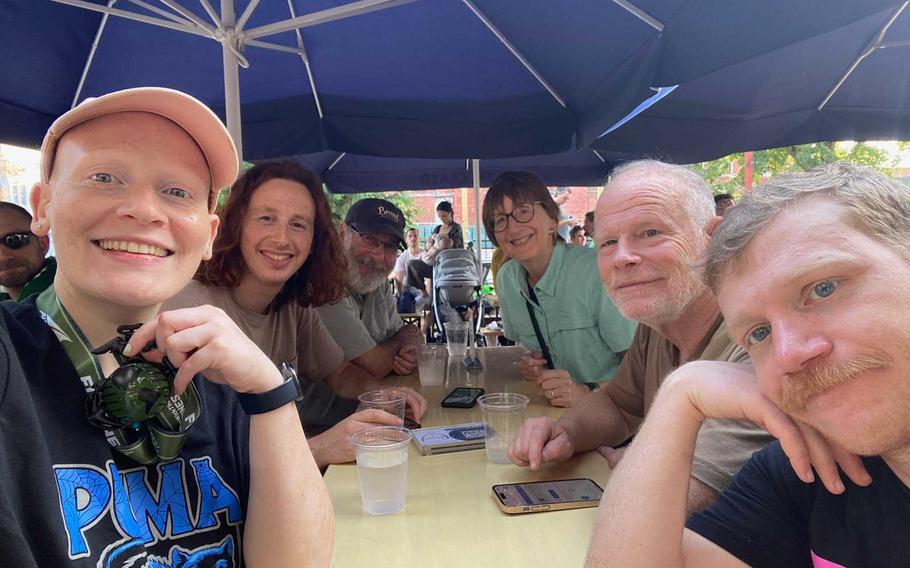
Joyce LaLonde, left, and her brother Timothy, far right, in Washington with other family members after they completed the 48th Marine Corps Marathon in Arlington, Va., on Oct. 29, 2023. Shortly after this photo was taken, Timothy and Joyce found Gen. Eric M. Smith lying unresponsive on the ground. MUST CREDIT: LaLonde family (Photo by LaLonde family)
The stricken stranger
The LaLonde family encountered Smith shortly before 5 p.m., with Joyce LaLonde, 28, and her husband, Nathaniel Birnbaum, 28, first to arrive at the general’s side, she said. Timothy LaLonde, 33, and their father, Steven LaLonde, 66, were a few paces behind. They turned the stricken stranger on his side before deciding CPR was necessary.
Joyce LaLonde was put on hold initially when she dialed D.C.’s 911 system, she said, prompting her to hang up, call again, and urge her husband to try to find help at a nearby police station. The delay did not prove fateful, but has occurred numerous times in the District, as it struggles with documented staffing shortages. She connected with a dispatcher at 4:58 p.m., relaying her location and the situation’s extreme urgency, said Noah Gray, a spokesman for the D.C. fire department.
D.C.’s Office of Unified Communications offered no details in response to questions about the incident, but acknowledged in an email that the 911 system sometimes gets an “unpredictable spike in calls” that results in callers hearing an automated message. The office recommended against hanging up in such cases.
Timothy LaLonde, of Kirkland, Wash., estimated that he administered CPR for about nine minutes, pumping Smith’s chest and checking to see if anything was blocking his airway. Eventually, the general began gasping sporadically, giving the LaLondes hope.
A four-man team with Engine Company 18 arrived about five minutes after the 911 call, said Ryan Crowell, a former D.C. paramedic and firefighter who responded that day. They took over CPR, zapped Smith with an automated defibrillator, loaded him aboard an ambulance, and rolled to the hospital at 5:18 p.m.
No one knew they were working on one of the Pentagon’s top generals.
Lt. Holly O’Byrne, a paramedic and supervisor who accompanied the general in the ambulance, said that as it became increasingly clear Smith was responding to treatment, she administered medication to stabilize his blood pressure and heart rate, intubated him and assisted his breathing by squeezing a handheld air bag. The general’s piercing blue eyes caught her attention, she recalled.
MacGillivray, the cardiac surgeon, said that when Smith arrived at MedStar Washington Hospital Center, it appeared the general may have had a heart attack. But his care team soon diagnosed it was aortic stenosis, a condition in which the aortic valve narrows, preventing the normal flow of blood away from the heart. Smith was treated that night with a tiny wire that inflates like a balloon to reopen the valve and a small implanted defibrillator designed to detect any future cardiac arrest or arrhythmia, the surgeon said.
“We stabilized him with the balloon, but that did not solve the problem,” MacGillivray said. “That was kind of like throwing someone a life jacket.”
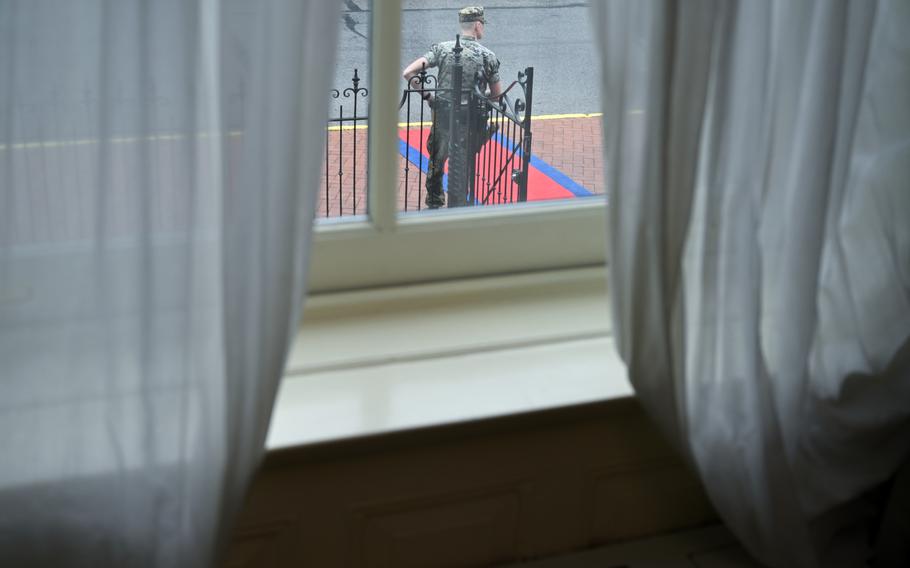
A Marine stands outside the residence of Gen. Eric M. Smith before a ceremony in which he recognized Timothy LaLonde, his sister Joyce LaLonde and her husband Nathaniel Birnbaum on Thursday. MUST CREDIT: Matt McClain/The Washington Post (Matt McClain)
Looking for ‘John Doe’
A block away from where Smith had collapsed, the general’s wife, Patrisha, had been waiting outside for a delivery at the Home of the Commandants, the venerable residence where the top Marine Corps general lives. She could see an ambulance in the distance, she recalled.
“I just remember thinking to myself, ‘Oh, they’ve got their lights on so they’re transporting somebody,’” she said. “Little did I know that it was Eric in the back of that ambulance.”
For a while, she thought that maybe her husband had stopped to talk to Marines. Marathon day is typically bursting with energy, and it would not have been unusual for him to do so.
But as minutes turned to hours, she began to worry. She and the general’s staff urgently sought to track him down, visiting two hospitals where unnamed patients - listed as “John Does” - had been admitted. Smith was carrying a government ID, his wife said, but in the commotion to save his life, it had been missed. They found him at the second hospital.
Patrisha Smith, her voice thickening, said she did not initially realize how critical the situation was. She is grateful that the nurses who allowed her to stay with her husband that night in the intensive care unit did not overwhelm her with details.
“They might have thought that he wasn’t going to make it,” she said. “But they didn’t relay that to me. And I appreciate that because it gave me hope.”
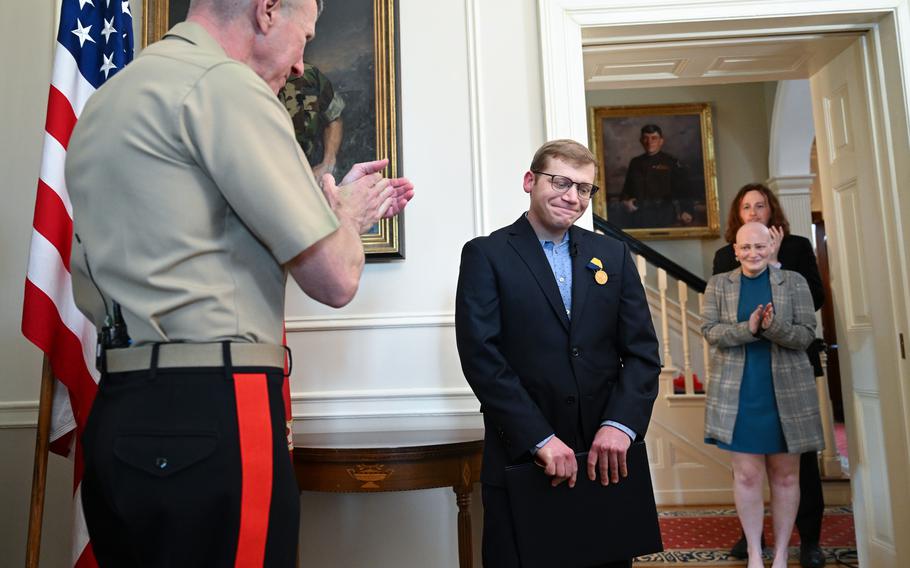
Gen. Eric M. Smith, left, applauds Timothy LaLonde. (Matt McClain/The Washington Post)
‘We saved America!’
Once the paramedics took over, the LaLondes continued on to Joyce’s home. Three of them had blood on their clothes, she said, from having attempted to ensure the general’s injured mouth was clear of obstructions. The situation had been intense, and she doubled back to the scene about 20 minutes later, providing her contact information to authorities in case it would be helpful.
The family’s first hint that the patient was someone of prominence came a few hours later. While attending a concert by the singer Kesha, Joyce received a call from an agent with the Naval Criminal Investigative Service who wanted to know more about the incident, she said.
Two days later, on Oct. 31, the Marine Corps disclosed that Smith had been hospitalized with a health emergency. D.C. officials linked the situation with the cardiac arrest case that the LaLondes had been involved in, catching the attention of the first responders who were involved.
O’Byrne, the paramedic who had intubated Smith, said she was sent a photograph of Smith and asked if it was the person she had helped. His bright blue eyes were unmistakable, she said.
“My actual comment was, ‘Holy s---, we saved America!’” she said. “That became how I told Firefighter Crowell … ‘Hey, guess what: We saved America!’”
Crowell, who has since moved back to his hometown of Syracuse, N.Y., said the incident underscores the unique nature of working emergency calls in the District.
“You never know,” Crowell said, “who the John Doe turns out to be.”
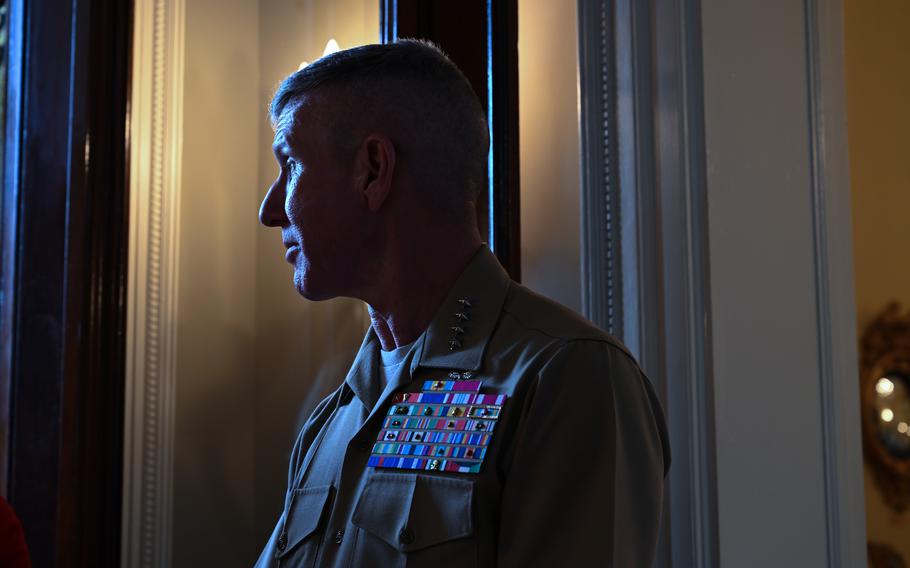
“You have really given me a second chance,” Gen. Eric M. Smith told the three bystanders who scrambled to rescue him. “I’m grateful to you.” (Matt McClain/The Washington Post)
‘I’ll bounce back’
Smith awoke in the hospital last fall remembering he had gone for a run, but nothing after, he said. He was frustrated with the discomfort of his breathing tube, whose presence damaged his vocal cords, and a couple of teeth had been knocked out and his face was scraped from his fall.
“Like all good Marines,” Smith joked, “I was complaining about my care.”
The seriousness of the situation soon became clear. While the general had survived cardiac arrest, he still had an aortic bicuspid valve that had failed. The condition, said MacGillivray, is congenital and meant that Smith’s aortic valve had only two parts, or “leaflets,” pumping blood away from the heart, rather than the customary three.
Valve replacement surgery is common, but often it occurs after a patient experiences chest pain, fatigue and other less severe symptoms that prompt treatment. Smith told MacGillivray that he had been aware of his condition, the doctor said, but he had lived with it for years without issue and typically ran three miles in about 18 minutes.
The surgeon also was concerned about how Smith’s extended emergency and lack of oxygen might affect other parts of his body. Smith initially had some abnormal kidney tests, MacGillivray said, but they improved quickly. The general’s overall physical fitness assisted in his recovery, the doctor said, though he required time to heal from the trauma of his resuscitation before undergoing open-heart surgery.
As his recuperation continued, Smith decided he also needed to record a message to show the Marines that he was okay. On Nov. 21, about three weeks after his cardiac arrest, he made a brief video thanking the Marines for their support. Smith wished them a happy Thanksgiving, and vowed he would be back.
“It’s not the first time I’ve been knocked down,” he told them, peering at the camera in his green camouflage uniform. “When I was shot in 2004, I bounced back from that, and I’ll bounce back from this.”
On Jan. 8, Smith underwent surgery to have MacGillivray install a mechanical replacement valve. The procedure, the surgeon said, was a success, and Smith stepped back into his role as commandant without any physical restrictions. The general is back to weightlifting a few times per week, he said, with the tick-tick-tick of his mechanical valve an audible reminder of how far he has come.
“It’s like a little stopwatch. I can hear it ticking,” Smith said. “But it’s a good sound because it means I’m alive.”
Smith said that while he saw his “fair share of combat” in Iraq and Afghanistan, including the gunshot wound in Iraq and several explosions, the situation in the District last fall was different because he didn’t see it as a possibility.
“My mission that day was just to run three miles - just doing my fitness routine,” Smith said. “It’s very different having that happen and having to rely on so many people to get you healthy again.”
Timothy LaLonde, who kept the commandant alive with CPR on the sidewalk, said that while the “odds are pretty low” of surviving such an event, his training helped.
“I’m just really proud of everyone in my family for how they responded,” he said. “There was a lot of luck that came in that day.”
Smith said Thursday that meeting his rescuers for the first time was “very strange and very rewarding.” He and his wife decided they needed to do something to recognize those involved, he said, and hope it underscores the value of CPR training.
“If Mr. LaLonde had not been a CPR-certified instructor,” the general said, “I would not be standing here today.”